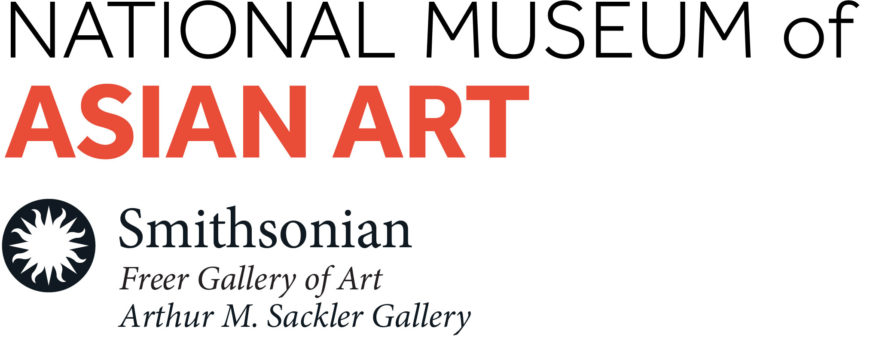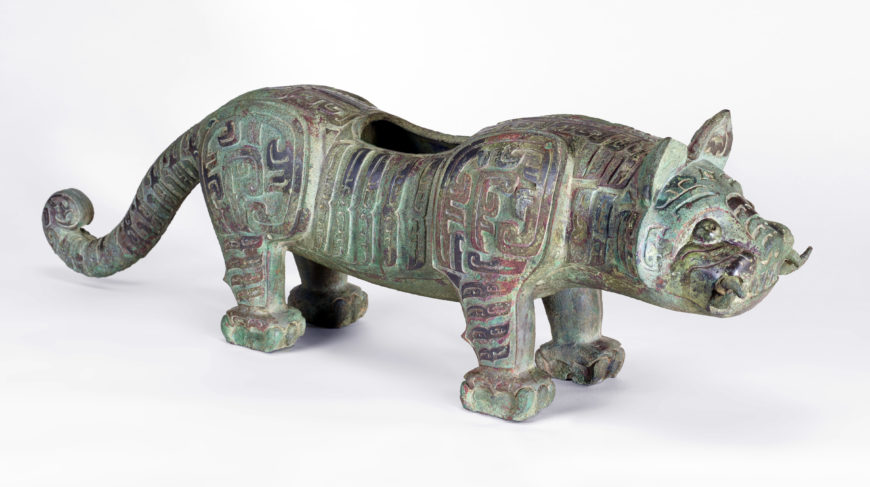
One of a pair of tigers, possibly the base supports for a bell stand, Middle Western Zhou dynasty, c. 950–850 B.C.E., bronze, China, Shaanxi province, Baoji, 25.3 high x 15.9 x 75.2 cm (Freer Gallery of Art, Smithsonian Institution, Washington, DC: Purchase — Charles Lang Freer Endowment, F1935.21)
The Zhou people had their origins in the far western reaches of the Yellow River in present day Shaanxi province. They conquered the Shang around 1050 B.C.E. and established their own dynasty. The Zhou shared many cultural similarities with the Shang. They performed similar religious rituals, used bronze ritual vessels, and practiced divination.
During its first years, known as the Western Zhou (c. 1050–771 B.C.E.) because its capital was located in western China, the Zhou dynasty mirrored the Shang in ruling as a centralized empire. Since its territory was vast—larger than the Shang—the early Zhou kings developed a form of feudalism with regions ruled by appointed relatives and other noblemen. To legitimize their overthrow of Shang, they introduced the concept of Heaven (Tian), and the Mandate of Heaven. They believed that a king could
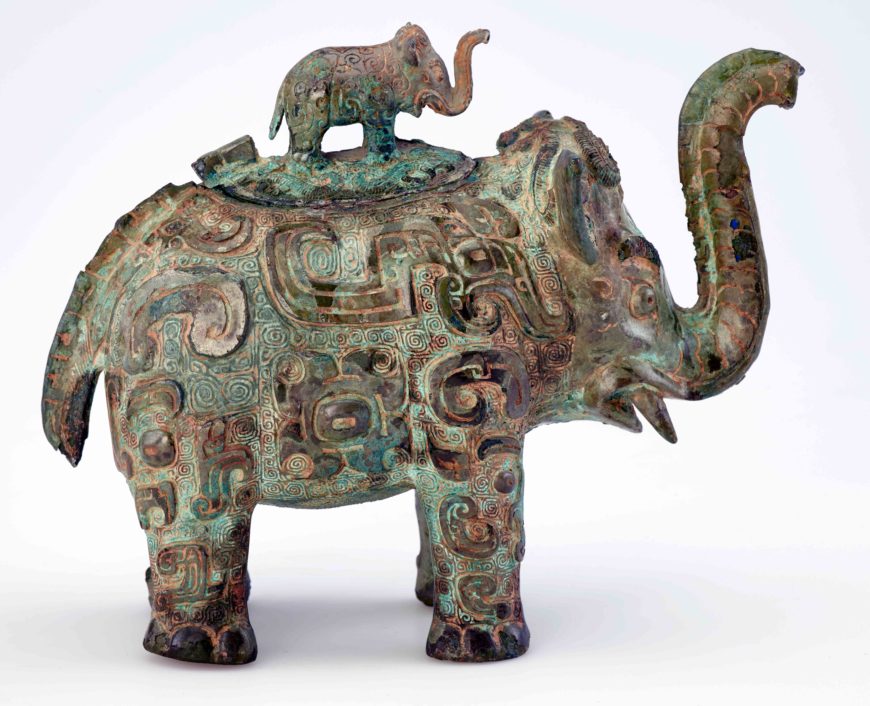
Lidded ritual ewer (huo) in the form of an elephant with masks and dragons, ca. first half 11th century B.C.E. (Shang dynasty), bronze, 17.2 high x 10.7 x 21.4 cm, China, Middle Yangzi Valley (Freer Gallery of Art, Smithsonian Institution, Washington, DC: Purchase — Charles Lang Freer Endowment, F1936.6a-b)
rule only if he received heaven’s favor. This belief carried a sacred moral power and required that a king, the Son of Heaven, be a virtuous ruler. The arts of the early Zhou were essentially a continuation of those of the Shang dynasty. That was especially true of bronze casting and jade working. The Zhou people used Shang bronze designs as a foundation for their own decorative bronzes, but they also introduced new motifs and shapes.
Over time, the Zhou kings’ authority decreased as the individual states grew more independent, wealthy, and powerful. In addition, a nomadic invasion forced Zhou rulers to flee to the east and build a new capital at modern-day Luoyang. This marked the beginning of the period known as the Eastern Zhou dynasty (771–221 B.C.E.). The Eastern Zhou was an era of intense political turmoil. States were at constant war with one another for land and political control. In fact, the latter half of the period is known as the Warring States Period (475–221 B.C.E.), when the small states eventually consolidated into seven strong kingdoms. These seven states fought with each other for mastery until one of them, Qin, succeeded and established the Qin dynasty (221–206 B.C.E.).
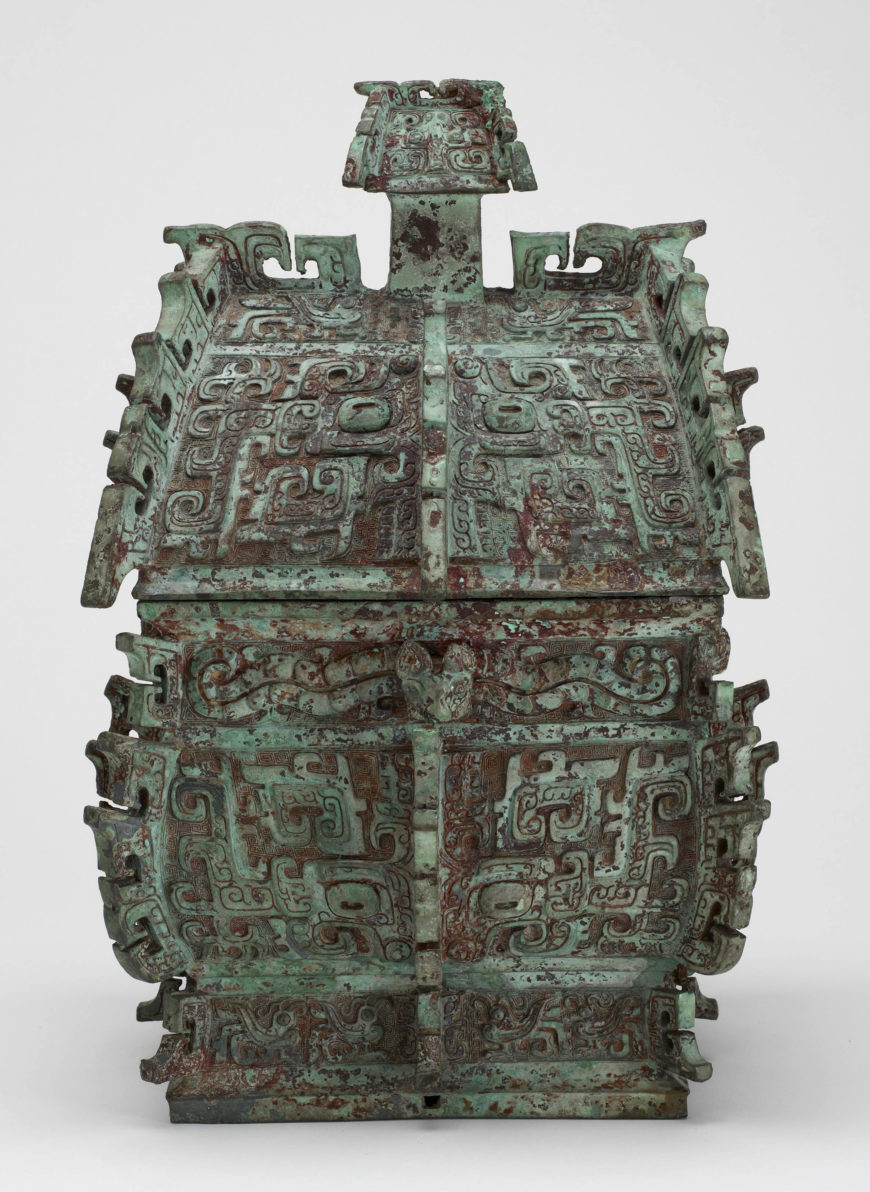
Square lidded ritual wine container (fangyi) with taotie, serpents, and birds, Early Western Zhou dynasty, c. 1050–975 B.C.E., Bronze, China, Henan province, Luoyang, 35.3 high x 24.8 x 23.3 cm (Freer Gallery of Art, Smithsonian Institution, Washington, DC: Purchase — Charles Lang Freer Endowment, F1930.54a-b)
The weakening of central Zhou authority is reflected in the visual arts. Bronze objects were no longer used solely for state and religious rituals. Local rulers could commission and purchase bronzes to display their status and wealth. This was evident in bronze inscriptions. Zhou bronze inscriptions (such as one on a square lidded ritual wine container) lengthened and often recorded some honor or achievement of the living aristocrat, reflecting the elite’s desire to document their status and prestige.
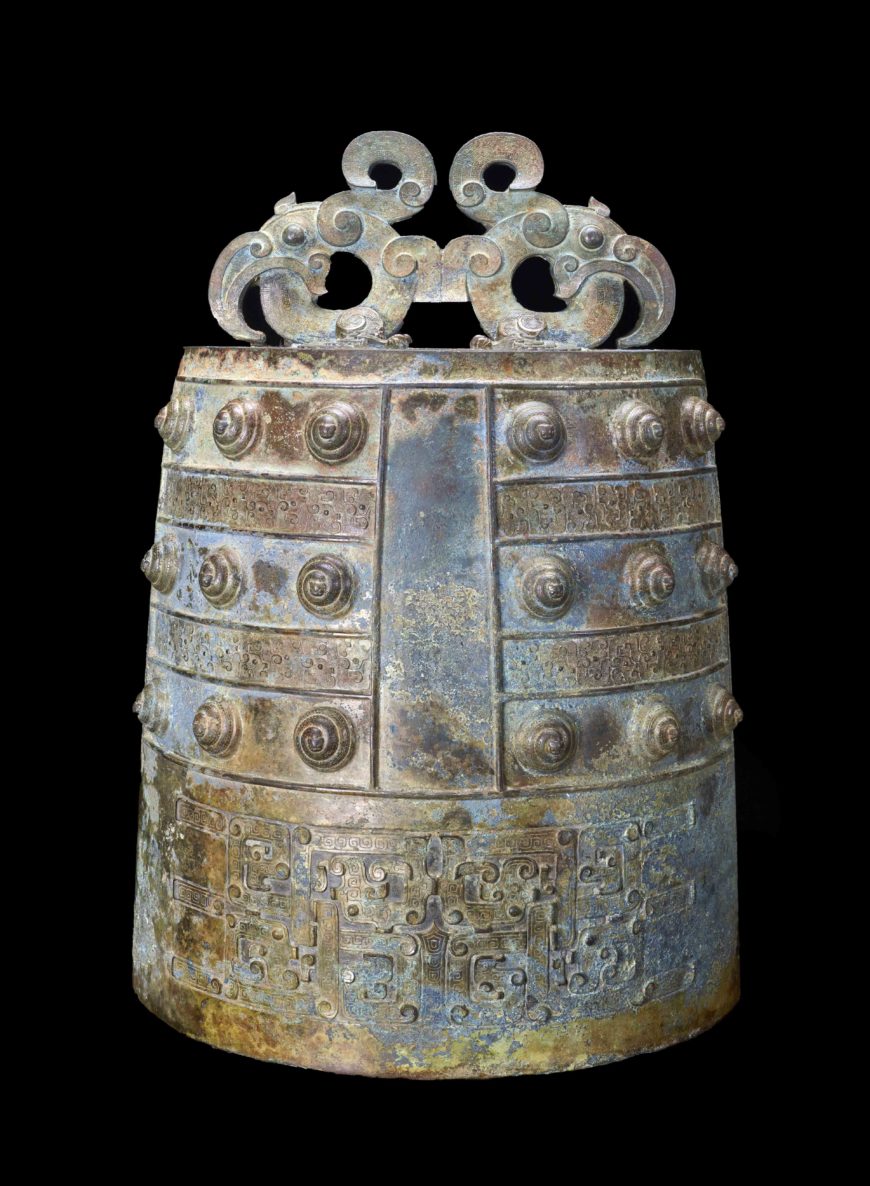
Bell (bo) with birds and dragons; from a set of four, late Spring and Autumn period, Eastern Zhou dynasty, c. 500–450 B.C.E., bronze, China, Shanxi province, State of Jin, Houma foundry, 66.4 high x 47 cm (Freer Gallery of Art, Smithsonian Institution, Washington, DC: Purchase — Charles Lang Freer Endowment, F1941.9)
A new addition to Zhou bronzes are musical instruments, including bells. From the ample discovery of musical instruments in Zhou tombs, it is evident that music played an extremely important role in the Zhou dynasty, whether for religious or recreational purposes. New decorative techniques were invented.
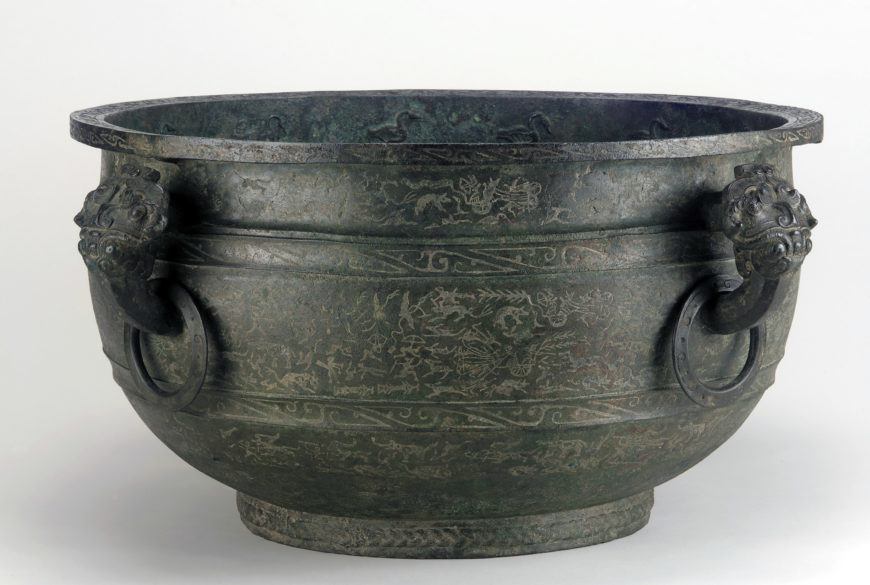
Basin (jian) with narrative scenes, Middle Eastern Zhou dynasty, c. 5th century B.C.E., bronze, China, 28 high x 61.4 cm (Freer Gallery of Art, Smithsonian Institution, Washington, DC: Gift of Charles Lang Freer, F1915.107)
Pictorial depictions of ancient Chinese life, such as hunting scenes (like on a basin or jian), appeared for the first time. New casting techniques, such as the lost-wax method, made possible an even greater range of styles and decoration.
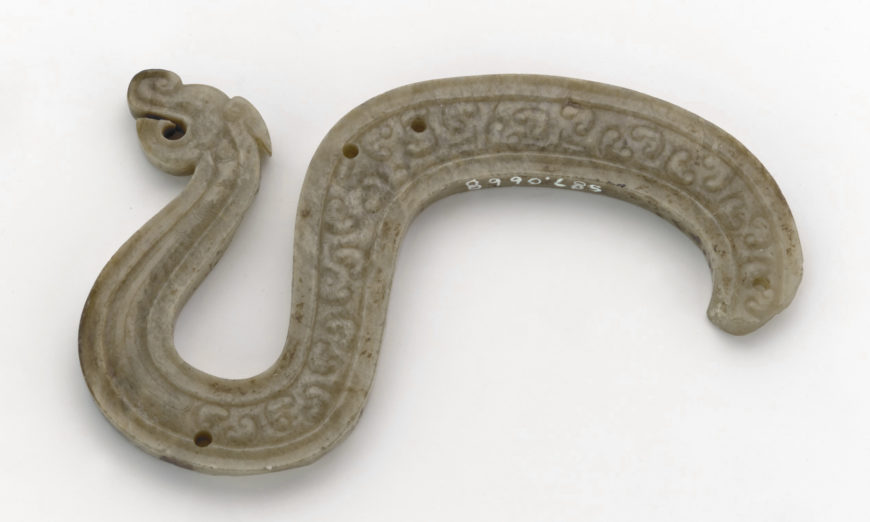
Dragon pendant, Eastern Zhou dynasty, 750-500 B.C.E., jade, 6.2 x 9.2 x 0.5 cm, China (Arthur M. Sackler Gallery, Smithsonian Institution, Washington, DC: Gift of Arthur M. Sackler, S1987.668)
The jade objects of the Zhou were larger in number compared to those of the Shang and made in a wider variety of styles. Like bronzes of the period, jades were used less often as ritual objects and more as ornaments and symbols of status and wealth.
The arts and humanities also flourished during the Eastern Zhou dynasty. Many of China’s great thinkers lived during this period. New ideas of all kinds emerged, including the schools of Confucianism (emphasizing social and family structure), Daoism (following the patterns of nature), and legalism (promoting systematic rewards and punishments). They addressed the most important question of the time: how to create a stable and harmonious society. These competing philosophies and systems of thought continued to influence Chinese beliefs in later eras, and many of them are still in active use today.
This resource was developed for Teaching China with the Smithsonian, made possible by the generous support of the Freeman Foundation
Additional resources:
See this essay on the Teaching China resources from the Smithsonian
George W. Weber Jr. The Ornament of Late Chou Bronzes: A Method of Analysis. New Brunswick. pl. 52.
William Watson. The Art of Dynastic China. New York, 1981. ill. 262.
Sekai bijutsu zenshu [A Complete Collection of World Art]. 40 vols., Tokyo, F1951-1953. cat. 81-82.
Mizuno Seiichi. In Shu seidoki to tama [Bronzes and Jades of Ancient China]. Tokyo. pls. 152-153.
Hai wai i chen [Chinese Art in Overseas Collections]. Taipei, 1985. vol. 2, p. 125.
Chugoku bijutsu [Chinese Art in Western Collections]. 5 vols., Tokyo, 1972-1973. fig. 72.
Noel Barnard. Bronze Casting and Bronze Alloys in Ancient China. Monumenta serica, no. 14 Canberra. pl. 29.
Jenny F. So. Eastern Zhou Ritual Bronzes from the Arthur M. Sackler Collections. Ancient Chinese Bronzes from the Arthur M. Sackler Collections, vol. 3 New York, 1995. vol. 3. p. 377, 447, fig. 77.4, M43.
Grace Dunham Guest, Archibald Gibson Wenley. Annotated Outlines of the History of Chinese Arts. Washington, 1949. p. 4.
compiled by the staff of the Freer Gallery of Art. A Descriptive and Illustrative Catalogue of Chinese Bronzes: Acquired During the Administration of John Ellerton Lodge. Oriental Studies Series, no. 3 Washington, 1946. pp. 7, 64-65, pl. 34-35.
Michael Sullivan. The Arts of China., 3rd ed. Berkeley. p. 45.
Sherman Lee. A History of Far Eastern Art. Englewood Cliffs, New Jersey, 1964. p. 45, fig. 38.
Dagny Carter. Four Thousand Years of China’s Art. New York. pp. 48-49.

